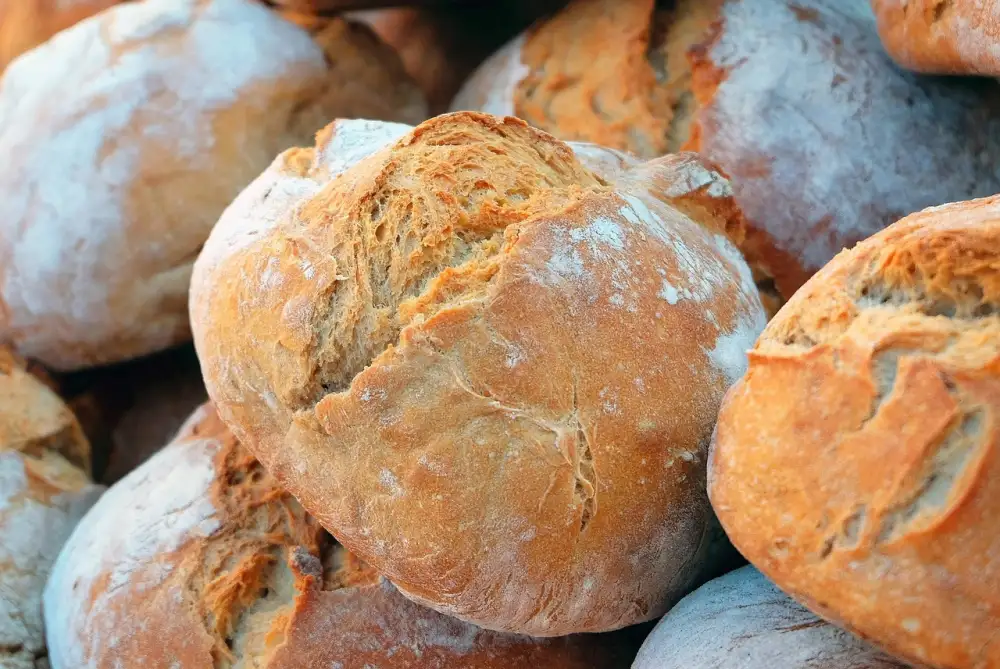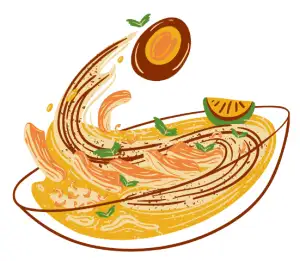Bread Bonanza: Mouthwatering Recipes to Savor the Staple Food Delight

Bread, a staple food enjoyed by cultures around the world, has been a dietary mainstay for centuries. It is a versatile and satisfying food that can be enjoyed in various forms, from crusty baguettes to soft sandwich loaves. Bread not only fills our bellies but also satisfies our senses with its enticing aroma and delicious taste. Whether it's used as a vessel for spreads and fillings or simply enjoyed on its own, bread plays an integral role in many cuisines globally. In this article, we will explore the history, types, recipes, health benefits, and culinary possibilities of this beloved staple food.
History and origins of bread
History and Origins of Bread
Bread, a staple food enjoyed by cultures around the world, has a rich history that dates back thousands of years. The origins of bread can be traced to ancient civilizations such as Egypt, Mesopotamia, and Greece. The first evidence of bread-making dates back to around 10,000 BC in what is now modern-day Jordan.
Initially, bread was made using simple ingredients like water and ground grains. The discovery of wild yeast led to the fermentation process, which gave rise to leavened bread. This innovation revolutionized bread-making techniques and resulted in lighter and more flavorful loaves.
In ancient Egypt, bread held great significance both as a dietary staple and as an offering to the gods. The Egyptians were skilled bakers who developed various types of bread using different grains like barley and emmer wheat.
The Romans also played a significant role in the history of bread. They introduced milling techniques that produced finer flour, resulting in softer loaves. They even established bakeries throughout their empire to meet the growing demand for bread.
As trade routes expanded, so did the variety of breads available worldwide. Each culture developed its own unique recipes and techniques based on local ingredients and traditions. From baguettes in France to naan in India, every country boasts its own distinct type of bread.
The industrial revolution marked another milestone in bread production with the invention of mechanized processes such as kneading machines and steam ovens. These advancements made it possible to produce large quantities of bread quickly and efficiently.
Today, bread continues to be a beloved food worldwide due to its versatility, taste, and nutritional value. Its long history reflects its importance as a fundamental part of human diets across different eras and cultures.
Different types of bread from around the world
Different types of bread from around the world offer a diverse range of flavors, textures, and cultural significance. In France, the baguette is an iconic symbol of French cuisine, with its crisp crust and soft interior. Italy is famous for its ciabatta bread, known for its irregular shape and chewy texture. Germany boasts the pretzel, a twisted bread with a salty crust. India's naan is a popular flatbread made with yogurt and traditionally cooked in a tandoor oven. In Mexico, tortillas are a staple, made from corn or wheat flour and used to wrap various fillings. These are just a few examples of the countless varieties of bread enjoyed worldwide.
Basic ingredients and process of making bread
Bread, a staple food enjoyed by people worldwide, is made using simple ingredients and a straightforward process. The basic ingredients for making bread include flour, water, yeast, and salt. Flour provides the structure and texture of the bread, while water activates the yeast and helps in gluten formation. Yeast is responsible for fermentation, which gives bread its characteristic rise and flavor. Salt enhances the taste and controls yeast activity.
The process of making bread involves several steps. First, the dry ingredients (flour, yeast, and salt) are combined in a mixing bowl. Then, warm water is gradually added to form a dough. Kneading the dough helps develop gluten strands that give bread its elasticity. After kneading, the dough is left to rise in a warm place until it doubles in size.
Once risen, the dough is shaped into loaves or rolls and placed in a preheated oven to bake. During baking, heat causes the yeast to produce carbon dioxide gas, creating air pockets that result in a light and fluffy texture. The crust forms as the outer layer of the bread browns due to Maillard reactions.
The baking time varies depending on the type of bread being made but typically ranges from 20 to 45 minutes. To check if it's done, tap the bottom of the loaf – it should sound hollow.
Mastering the art of making bread requires practice and patience. With experience, bakers can experiment with different types of flour (such as whole wheat or rye) or add additional ingredients like herbs or nuts to create unique flavors and textures.
Making homemade bread not only fills your home with an irresistible aroma but also allows you to enjoy freshly baked goodness straight from your oven. So why not roll up your sleeves and embark on this delightful culinary adventure?
Popular bread recipes and variations
Popular bread recipes and variations offer a delightful array of flavors and textures. One beloved recipe is the classic French baguette, known for its crisp crust and soft interior. Another favorite is the Italian ciabatta, with its chewy texture and rustic appearance. For those seeking a sweeter option, cinnamon raisin bread provides a delectable combination of warm spices and plump raisins. Additionally, whole wheat bread offers a healthier alternative, packed with fiber and nutrients. Other variations include sourdough, rye, pita, and naan – each with its own distinct taste and cultural significance. These diverse recipes allow us to explore the endless possibilities of this timeless staple food.
Health benefits of consuming bread
Bread, as a staple food, offers numerous health benefits when consumed in moderation. It is a rich source of carbohydrates, which provide energy for our bodies. Whole grain breads are particularly beneficial as they contain the entire grain, including the bran and germ, which are packed with fiber, vitamins, and minerals.
The fiber content in bread aids in digestion and helps maintain a healthy digestive system. It also promotes satiety, making us feel full for longer periods and reducing the likelihood of overeating. Additionally, the fiber in bread can help regulate blood sugar levels and lower the risk of developing type 2 diabetes.
Bread is also a good source of essential nutrients such as iron, calcium, and B vitamins. Iron is crucial for transporting oxygen throughout the body while calcium strengthens bones and teeth. B vitamins play a vital role in metabolism and maintaining overall health.
Furthermore, whole grain breads have been associated with a reduced risk of heart disease due to their high fiber content. They can help lower cholesterol levels and maintain healthy blood pressure.
It's important to note that not all breads are created equal when it comes to health benefits. Opting for whole grain or whole wheat varieties over processed white breads is recommended to maximize nutritional value.
In conclusion, incorporating bread into a balanced diet can provide essential nutrients, promote digestion, regulate blood sugar levels, reduce the risk of heart disease, and contribute to overall well-being. However, moderation is key to ensure optimal health benefits from this beloved staple food.
Tips for storing and preserving bread
Tips for Storing and Preserving Bread
To keep your bread fresh and delicious for longer, here are some handy tips for storing and preserving it:
1. Store in a cool, dry place: Bread is best stored in a cool, dry place, away from direct sunlight and moisture. Avoid storing it in the refrigerator as it can cause the bread to become stale faster.
2. Use a bread box or bread bag: Invest in a good quality bread box or use a breathable bread bag to store your loaf. These containers help to maintain the right level of moisture while preventing excessive drying.
3. Freeze for long-term storage: If you have extra bread that you won't be able to consume within a few days, consider freezing it. Slice the bread before freezing so you can easily thaw individual portions when needed.
4. Wrap properly: When storing bread, wrap it tightly in plastic wrap or aluminum foil to prevent air exposure. This will help retain moisture and prevent the bread from becoming dry.
5. Avoid slicing until ready to use: Sliced bread tends to dry out faster than whole loaves. To keep your bread fresh, avoid slicing it until you're ready to use it.
By following these simple tips, you can extend the shelf life of your favorite loaf and enjoy fresh-tasting bread for longer periods of time.
Bread as a versatile ingredient in various dishes
Bread, with its diverse textures and flavors, is not just a standalone food item but also a versatile ingredient that adds depth and character to various dishes. From breakfast to dinner, bread can be transformed into delectable creations.
In the morning, toast slices of bread and top them with avocado and poached eggs for a nutritious and satisfying breakfast. Or use bread to make French toast, soaking it in a mixture of eggs, milk, and cinnamon before frying it until golden brown.
For lunch or dinner, bread can be used as a base for sandwiches or burgers. Whether it's a classic BLT sandwich or a juicy burger with all the fixings, the bread acts as the foundation that holds everything together.
Bread can also be transformed into croutons for salads or soups. Simply cube stale bread, toss it with olive oil and seasonings like garlic powder or dried herbs, then bake until crispy. These homemade croutons add crunch and flavor to any dish.
In addition to savory dishes, bread can be used in desserts too. Bread pudding is a popular sweet treat made by soaking stale bread in a mixture of milk, eggs, sugar, and spices before baking it to perfection. Serve it warm with a drizzle of caramel sauce for an indulgent dessert.
The versatility of bread extends beyond meals; it can be used in appetizers as well. Bruschetta is an Italian dish where toasted slices of bread are topped with fresh tomatoes, basil, garlic, and olive oil. It's a simple yet flavorful starter that showcases the beauty of using bread creatively.
With its ability to adapt to different flavors and textures, bread truly shines as an ingredient in various culinary creations. Its neutral taste allows it to absorb the flavors of other ingredients while providing structure and substance to dishes. So next time you're looking for inspiration in the kitchen, don't forget about the endless possibilities that bread offers!
In conclusion, bread holds a significant place in our diets for several reasons. It has been a staple food for centuries, providing sustenance and nourishment to people around the world. The history and origins of bread showcase its cultural importance and its ability to bring communities together.
Bread is not only delicious but also versatile, with countless variations and recipes available. From crusty baguettes to soft sandwich loaves, there is a bread for every taste preference. Its basic ingredients of flour, water, yeast, and salt make it accessible and affordable for all.
Furthermore, bread offers numerous health benefits. Whole grain breads are rich in fiber, vitamins, and minerals that contribute to a balanced diet. They provide sustained energy throughout the day and aid digestion. Additionally, certain types of bread are fortified with essential nutrients like iron and folic acid.
Proper storage is crucial to preserve the freshness of bread. Storing it in a cool, dry place or freezing it can extend its shelf life. However, consuming fresh bread is always recommended for the best taste experience.
Lastly, bread's versatility extends beyond being a standalone food item. It can be used as an ingredient in various dishes such as sandwiches, croutons, breadcrumbs, and even desserts like bread pudding or French toast.
In conclusion, bread is more than just a basic food item; it represents tradition, culture, and comfort. Its significance in our diets cannot be understated. So let us savor the delightful world of bread and appreciate its role in bringing joy to our tables each day.
Published: 02. 03. 2024
Category: Food



